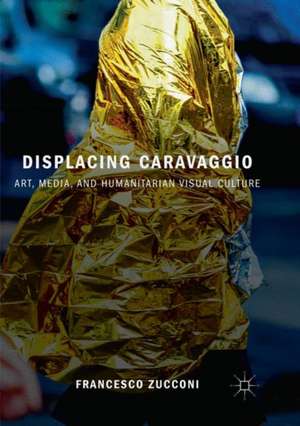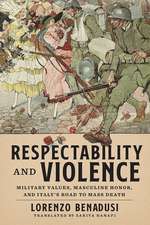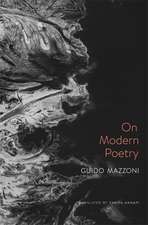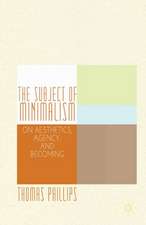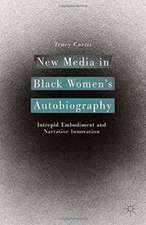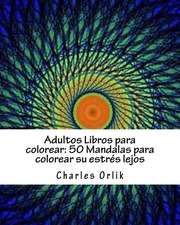Displacing Caravaggio: Art, Media, and Humanitarian Visual Culture
Autor Francesco Zucconi Traducere de Zakiya Hanafien Limba Engleză Paperback – 8 ian 2019
This book takes its start from a series of attempts to use Caravaggio’s works for contemporary humanitarian communications. How did his Sleeping Cupid (1608) end up on the island of Lampedusa, at the heart of the Mediterranean migrant crisis? And why was his painting The Seven Works of Mercy (1607) requested for display at a number of humanitarian public events? After critical reflection on these significant transfers of Caravaggio’s work, Francesco Zucconi takes Baroque art as a point of departure to guide readers through some of the most haunting and compelling images of our time. Each chapter analyzes a different form of media and explores a problem that ties together art history and humanitarian communications: from Caravaggio’s attempt to represent life itself as a subject of painting to the way bodies and emotions are presented in NGO campaigns. What emerges from this probing inquiry at the intersection of art theory, media studies and political philosophy is an original critical path in humanitarian visual culture.
| Toate formatele și edițiile | Preț | Express |
|---|---|---|
| Paperback (1) | 369.19 lei 38-44 zile | |
| Springer International Publishing – 8 ian 2019 | 369.19 lei 38-44 zile | |
| Hardback (1) | 532.05 lei 3-5 săpt. | |
| Springer International Publishing – 26 oct 2018 | 532.05 lei 3-5 săpt. |
Preț: 369.19 lei
Nou
Puncte Express: 554
Preț estimativ în valută:
70.64€ • 73.96$ • 58.45£
70.64€ • 73.96$ • 58.45£
Carte tipărită la comandă
Livrare economică 01-07 aprilie
Preluare comenzi: 021 569.72.76
Specificații
ISBN-13: 9783030066499
ISBN-10: 3030066495
Pagini: 244
Ilustrații: XI, 244 p. 34 illus., 23 illus. in color.
Dimensiuni: 148 x 210 mm
Ediția:Softcover reprint of the original 1st ed. 2018
Editura: Springer International Publishing
Colecția Palgrave Macmillan
Locul publicării:Cham, Switzerland
ISBN-10: 3030066495
Pagini: 244
Ilustrații: XI, 244 p. 34 illus., 23 illus. in color.
Dimensiuni: 148 x 210 mm
Ediția:Softcover reprint of the original 1st ed. 2018
Editura: Springer International Publishing
Colecția Palgrave Macmillan
Locul publicării:Cham, Switzerland
Cuprins
1. Introduction.- 2. Humanitarian Archeology.- 3. Unstill Life.- 4. Pathos, Survival, and “Quasi Immanence”.- 5. On the Limits of the Virtual Humanitarian Experience.- 6. Caravaggio on Lampedusa.- 7. On Displacing.
Recenzii
“This book presents a useful and compelling analysis of how art history can be mobilised alongside contemporary visual culture in the service of humanitarian communication and sheds light on the potentials and challenges of drawing on the historical legacy of classical painting.” (Tijana Stolic, Contemporary Political Theory, July 13, 2020)
“Francesco Zucconi has produced a wonderful study that considers how Caravaggio’s paintings have been involved in the politics of the humanitarian crisis in the Mediterranean. … I, for one, will certainly be following with great interest where the methodological displacement of the archive of art history will take him next.” (Matthew D’Ambrosio Griffith, Journal of Italien Cinema & Media Studies, JICMS, January, 2020)
“Francesco Zucconi has produced a wonderful study that considers how Caravaggio’s paintings have been involved in the politics of the humanitarian crisis in the Mediterranean. … I, for one, will certainly be following with great interest where the methodological displacement of the archive of art history will take him next.” (Matthew D’Ambrosio Griffith, Journal of Italien Cinema & Media Studies, JICMS, January, 2020)
Notă biografică
Francesco Zucconi is Assistant Professor at the IUAV University of Venice, Italy. He has been a Lauro de Bosis fellow at Harvard, USA, and a Marie Skłodowska-Curie fellow at the Centre d’Histoire et de Théorie des Arts, École des Hautes Études en Sciences Sociales (EHESS) in Paris, France, where he remains an associate member. He has written a number of books and articles on the theory of cinema, image theory and contemporary visual culture.
Translated by Zakiya Hanafi, Independent Scholar, USA
Textul de pe ultima copertă
This book takes its start from a series of attempts to use Caravaggio’s works for contemporary humanitarian communications. How did his Sleeping Cupid (1608) end up on the island of Lampedusa, at the heart of the Mediterranean migrant crisis? And why was his painting The Seven Works of Mercy (1607) requested for display at a number of humanitarian public events? After critical reflection on these significant transfers of Caravaggio’s work, Francesco Zucconi takes Baroque art as a point of departure to guide readers through some of the most haunting and compelling images of our time. Each chapter analyzes a different form of media and explores a problem that ties together art history and humanitarian communications: from Caravaggio’s attempt to represent life itself as a subject of painting to the way bodies and emotions are presented in NGO campaigns. What emerges from this probing inquiry at the intersection of art theory, media studies and politicalphilosophy is an original critical path in humanitarian visual culture.
Caracteristici
Translated by Zakiya Hanafi Marks the first book to offer an archeology of “humanitarian visual culture” Challenges readers to reconsider the relationship between the representation of suffering in the repertory of Western art and contemporary communication Draws from a number of on-going discussions in different fields of study that are rarely considered together: art history, theory of media, visual studies and postcolonial studies Explores different media forms of humanitarian communication: from photography to the most recent devices of virtual reality cinema, through the tradition of lantern-slide lectures Investigates the real likelihood of “displacing” the West’s artistic heritage in order to develop a critical understanding of some of the most pressing problems of the contemporary scenario
